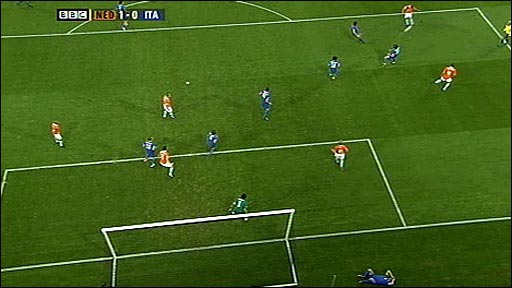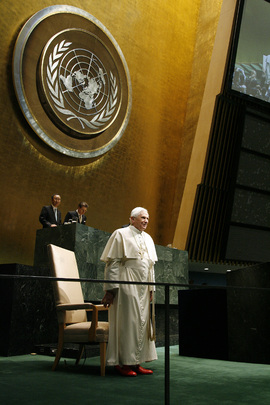
By Otto Spijkers
The first goal in the match between the Netherlands and Italy has triggered a lot of debate on the ‘legality’ of the goal. Was it according to the rules? The referee, who has the ultimate authority to apply the rules, decided to count the goal. But was that a correct decision? On the website of the BBC, the case is hotly debated, with over a 1000 comments attracted thus far. This is a summary of the facts of the case:
A Dutch player (Ruud van Nistelrooy) stands in front of the goal. He receives the ball from a fellow Dutchman who is further away from the goal line than van Nistelrooy at the time of passing, and van Nistelrooy then kicks the ball in the net. At that moment, there is no Italian defender between him and the keeper (see picture). Just behind the goal you can see an Italian defender, Christian Panucci, who seems injured at the time the goal is scored.
The applicable law is Rule 11 of the Laws of the Game 2007/2008. It states, as far as relevant:
Offside Position
A player is in an offside position if:
– he is nearer to his opponents’ goal line than both the ball and the second last opponent
A player is not in an offside position if:
– he is in his own half of the field of play or
– he is level with the second last opponent or
– he is level with the last two opponents.
When we wish to apply the law to the situation, we need first to look at the law itself and interpret it by using the textual method of interpretation, and, if that doesn’t solve the problem, we look at relevant case law, i.e. similar situations in the past, and authoritative interpretations of those situations. Continue reading




 The issue of equitable geographic representation at the various organs and bodies of the United Nations is always topical, so I guess it deserves a blog post even though I have no recent development relating to this issue to address specifically. It is an interesting topic, both for politicians and for those who like to work with statistics and calculators. The end-result of any application of the principle of equitable geographic representation, I guess, is always based on both cold calculation and hot politics. For a UN report on the issue, see
The issue of equitable geographic representation at the various organs and bodies of the United Nations is always topical, so I guess it deserves a blog post even though I have no recent development relating to this issue to address specifically. It is an interesting topic, both for politicians and for those who like to work with statistics and calculators. The end-result of any application of the principle of equitable geographic representation, I guess, is always based on both cold calculation and hot politics. For a UN report on the issue, see 
 The Dutch Member of Parliament, Mr.
The Dutch Member of Parliament, Mr. 